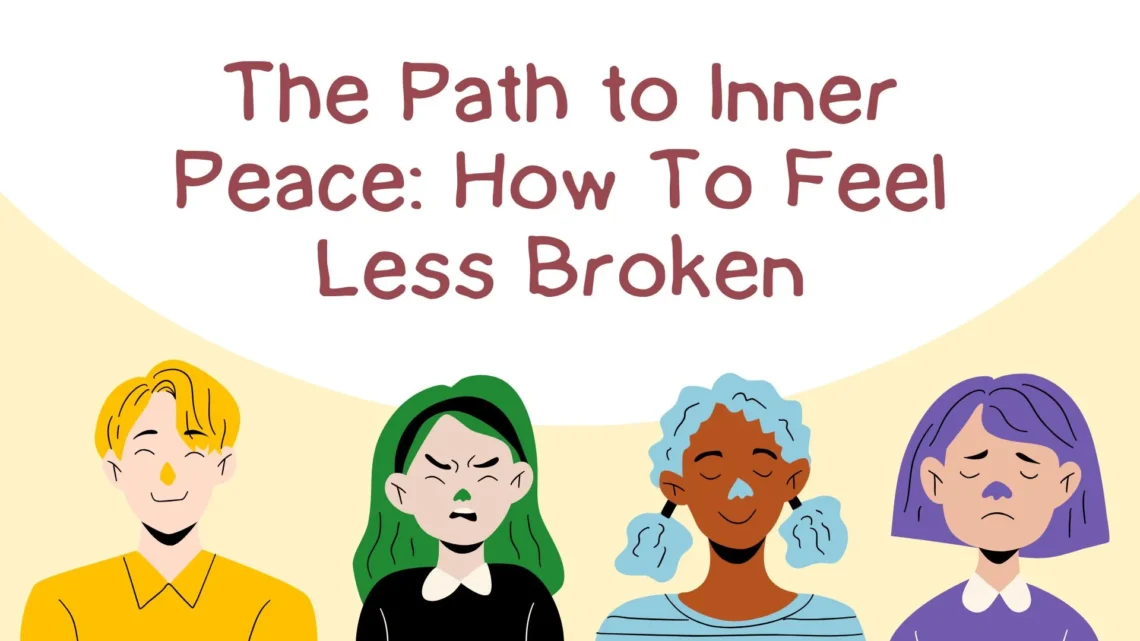
The Path to Inner Peace: How To Feel Less Broken?
Table of Contents
ToggleThe Path to Inner Peace: What Is Wrong with Me and How to Feel Less Broken
If you’ve ever found yourself grappling with the heavy question, “What is wrong with me?” you’re not alone. The journey to self-discovery and finding inner peace can often lead us through complex emotions and challenging experiences that may leave us feeling fragmented. The quest for a sense of wholeness is deeply personal, and it involves various approaches to healing both the mind and body. Continue reading to explore the path to inner peace and discover how they can guide you to feel less broken.
Cultivating Self-Compassion to Heal From Within
Self-compassion might be one of the most underrated tools in our mental health toolkit. The practice involves treating ourselves with the same kindness and understanding that we would offer a friend in distress. When grappling with thoughts like “what is wrong with me,” self-compassion encourages a nurturing dialogue that fosters healing.
Developing a compassionate inner voice can significantly impact how we cope with life’s challenges. It shifts the focus from self-critique to self-support, enabling individuals to navigate setbacks and perceived failures with grace and resilience. In essence, self-compassion lays the foundation for rebuilding one’s sense of self-worth and integrity.
While self-criticism often compounds the feeling of being broken, self-compassion acts as a salve. It permits us to acknowledge our pain and imperfections without becoming entangled in them. Embracing our humanity, including our flaws and vulnerabilities, becomes a gateway to emotional liberation.
Harnessing the Power of Positive Relationships
Human connection plays a vital role in the pursuit of inner peace. Positive relationships with friends, family, or even community members—offer emotional sustenance and a sense of belonging. When we connect with others in meaningful ways, it can affirm our worth and reduce feelings of isolation that often accompany inner turmoil.
The support derived from healthy relationships can act as a buffer against life’s adversities. Knowing that we have a network of individuals who care for us can serve as a reminder that we are not alone in our struggles. Furthermore, such relationships often provide opportunities for self-discovery and personal growth.
Engaging in open and honest communication is key to nurturing these positive connections. By sharing our experiences and vulnerabilities, we foster deeper bonds and create a shared understanding. This exchange of empathy and compassion can be profoundly healing and contribute significantly to feeling less fragmented.
The Importance of Forgiveness in Feeling Whole Again
Finding inner peace often requires the ability to forgive—others and, perhaps more importantly, ourselves. Holding on to past hurts or grievances can trap us in a cycle of anger and resentment. Forgiveness, on the other hand, is akin to releasing a heavy burden that we’ve been carrying, allowing us to move forward with a lighter heart.
Forgiveness does not mean condoning harm or dismissing one’s pain; it’s about liberating oneself from the shackles of lingering negativity. When we forgive, we assert control over our emotional well-being and refuse to let past woes dictate our present state. This act of empowerment can be profoundly liberating and integral to mending our inner fabric.
Letting go of self-blame is also critical for healing. Often, we may internalize failure or disappointment, questioning “What is wrong with me?” in a way that hinders recovery. Self-forgiveness invites a compassionate recognition of our fallibility and the acceptance that making mistakes is a universal aspect of the human experience.
Integrating Mind-Body Practices for Holistic Healing
The connection between mind and body is undeniable, and integrating practices that cater to both is crucial for holistic healing. Yoga, tai chi, and mindfulness-based stress reduction (MBSR) are examples of practices that merge physical activity with mental focus, leading to a greater sense of harmony and wholeness.
Through these mind-body practices, individuals can develop greater awareness of their physical sensations and emotions. This awareness can shine a light on the interplay between physical health and mental well-being, offering insights into how one may influence the other. As physical tension is released, mental relief often follows, creating a cycle of healing and peace.
Altogether, the road to feeling less broken is paved with self-awareness, compassion, and supportive relationships. It is a road that leads to forgiveness, both of others and oneself, and it encompasses a holistic approach that honors the profound connection between mind and body. Overall, the practices discussed not only aid in healing the present but also empower us to approach the future with resilience and grace.
Daily Habits for Sustained Inner Peace
Morning Routine
- Start your day with gratitude.
- Meditate or stretch for 10 minutes.
- Set positive intentions for the day.
Midday Practices
- Take short breaks to breathe and relax.
- Eat a healthy lunch mindfully.
- Step outside for fresh air and sunlight.
Evening Reflection
- Journal about your day’s experiences.
- Practice relaxation techniques, such as deep breathing.
- Read something inspiring before bed.
Conclusion About The Path to Inner Peace
In conclusion, the journey to inner peace and feeling less broken is deeply personal yet universally transformative. By embracing self-compassion, nurturing positive relationships, practicing forgiveness, and integrating mind-body techniques, we can begin to heal the emotional wounds that make us question, “What is wrong with me?” This path is not about erasing imperfections but about acknowledging them as part of our humanity and using them as stepping stones to growth and resilience. Inner peace comes from within, and by cultivating these practices, we can move forward with strength, self-awareness, and grace, embracing the wholeness we seek.
FAQs About The Path to Inner Peace
We have deeply covered everything about The Path to Inner Peace. However, if you have any other queries or questions in your mind about the Path to Inner Peace, don’t hesitate to use our Contact Us page to contact our team of experts. Our team will be available 24/7.
What is the value of living in inner peace?
What happens when you find inner peace?
Why do people need inner peace?
Tuba Hassan
Hi, I'm Tuba, a digital marketer and content writer with several years of experience in my field. My expertise in Search Engine Optimization (SEO) and Content Writing has helped me create engaging and effective content that resonates with my target audience. I’m passionate about helping businesses grow and thrive by developing and executing marketing strategies that drive growth and increase revenue.
You May Also Like

Benefits of Insulated Garage Doors for Canadian Winters
16 December 2024
How habits of men control their health?
31 December 2024

